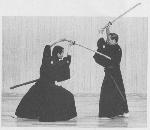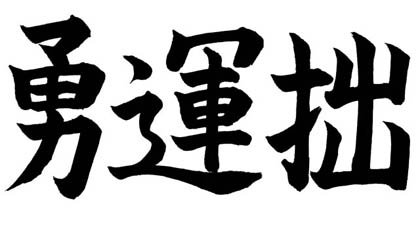Kumitachi 組太刀
 Kumitachi (組太刀) are paired practice (2 Man Forms). Different paired sets exists and have a high incidence of striking, grappling and disarms. Some waza use both long (ōdachi) and short (kodachi) swords.
Kumitachi (組太刀) are paired practice (2 Man Forms). Different paired sets exists and have a high incidence of striking, grappling and disarms. Some waza use both long (ōdachi) and short (kodachi) swords.
Some waza begin with swords drawn; others begin with swords sheathed and employ nukitsuke (drawing) techniques. Typically these forms are performed using bokutō; however, it is also practiced at high level with habiki or shinken.

Kumitachi are therefore a real plus for serious Iaido practitioner since they allow them to visualise and bridge the gap between standalone kata practice and partner interactive forms. Kumitachi allow to deepen and enrich the knowledge of concepts hard to understand while only working with kasso teki (invisible opponent):
– Maai (間合い) Distance / Timing
– Seme / Ki seme
– Zanshin
– Metsuke
– …
Different Kumitachi kata series exist in different koryu and can easily be added to Iaido cursus:
– Kendo no taka (10 forms, 7 Odachi / 3 Kodachi)
– Bokuto ni yoru kihon waza keiko ho (9 forms)
– Tachi uchi no kurai (10 forms)
– Tsumiai no Kurai
– Gogyo no kata
– Keishi Ryu Kidachi No Kata
– Hojo no kata (Jikishin kage)
– …

– The 3 types of distances between 2 opponents: Tōma (long distance), Issoku ittō-no-maai (one-foot-one-sword distance) also called chūma (middle distance), Chikama (short distance).
– The 5 basics kamae (on-guard positions): Hassō, Jōdan, Gedan, Wakigamae, Chūdan.
– The 3 different parts of the sword and their usage: Monouchi (Cutting area), Chu O and Tsubamoto.
Mitani, Yoshisato (1986). Shōkai Iai Musō Jikiden Eishin-ryū.
Posted: January 28th, 2010 under Iaido, Kendo.
Tags: bokken, bokuto ni yoru, kendo no kata, kumitachi, tachi uchi no kurai




